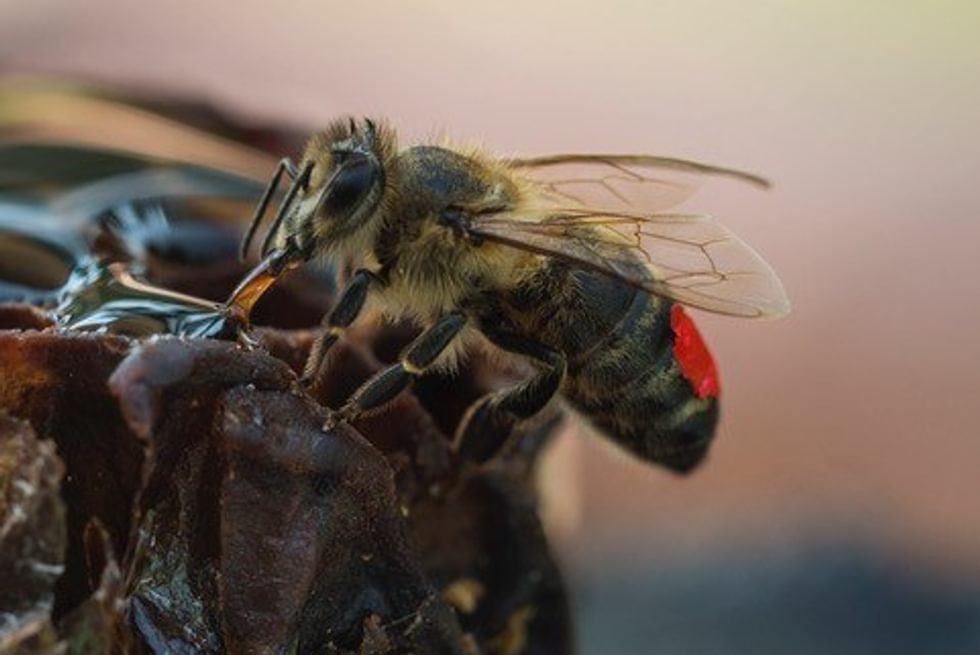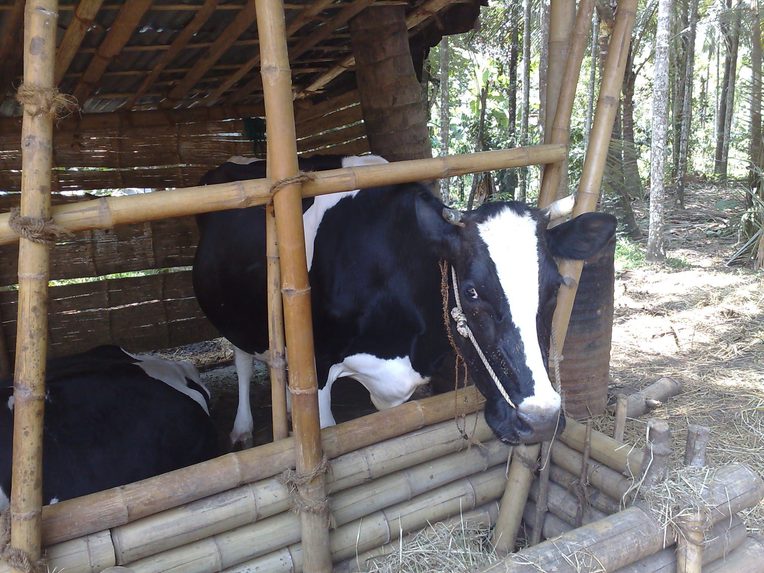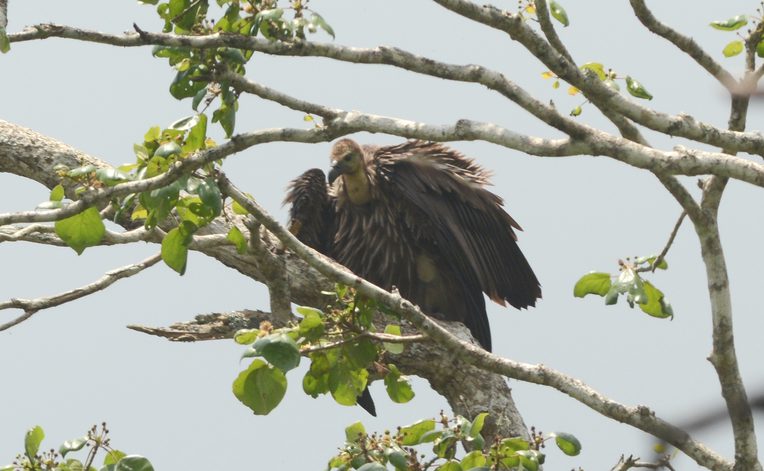Pharmaceutical Care: Diclofenac, a Pharmacon of More-Than-Human Health
From the Series: Multispecies Care in the Sixth Extinction
From the Series: Multispecies Care in the Sixth Extinction

After Mr. Chandran committed suicide, the Indian government offered his wife Ramini a dairy cow and a calf. This gift was part of an income generating scheme for impoverished widows of farmer suicides in India. Like many widows of small-scale settler farmers in the Wayanad district of Kerala, Ramini was struggling to make a living while dealing with the debts her husband had amassed in failed operations of ginger cultivation. Initially, Ramini hoped that the cows would produce steady income with the sale of milk to the local Milk Society. However, the “gift” of a high-yielding hybrid dairy cow came with a trade-off that put her on a treadmill of commercial inputs. With her cows, Ramini also entered the “chemosocial worlds” (Shapiro and Kirksey 2017) of productivist dairy farming.
Ramini’s cows were crosses of Indian Bos indicus breeds with high-yielding European Bos taurus breeds such as Swiss Brown and Frisian. In its biopolitical fight against “unproductive landraces” the government of Kerala introduced these breeds in the 1960s as part of a large-scale dairyfication program, known as the White Revolution, which has since boosted milk production. Breeding with native bulls was made illegal, leading to a near extinction of native breeds in the state (Münster 2017). Caring for “improved” hybrid breeds of cows demanded of small-scale farmers like Ramini the need to buy costly feed, keep her cows in a shed, and spend money on medicine. The same veterinary officer who had arranged the delivery of Ramini's “European” cow from a breeding station also administered their pharmaceutical care. If Ramini failed to provide proper infrastructure, food, and chemicals, her cow would give less milk, and she risked losing yield and income.

The introduction of hybrid cows in India coincided with global trends of the chemicalization of agriculture, medicine (Hardon and Sanabria 2017), and veterinary science (Brown and Nading 2019). Critical anthropologies of pesticides, synthetic fertilizers, and antibiotics have documented the toxic relations of food production in multispecies worlds (Dowdall and Klotz 2014; Münster 2015). In the shadow of antibiotics, diclofenac, a common painkiller also for human use, has become a “blockbuster drug” (Sunder Rajan 2017, 39) in more-than-human medicine. High-yielding cows undergo relentless cycles of pregnancy by artificial insemination, birth, and lactation. In India, diclofenac was the drug of choice to treat the many pains of high-performance cows, among them mastitis, a painful inflammation of the udder.
Diclofenac is a cheap, nonsteroidal anti-inflammatory drug (NSAID) and thus within the same class of pharmaceuticals as aspirin (ASS) or ibuprofen. Synthesized in the 1960s by chemists at the Swiss pharmaceutical company J.R. Geigy AG (Sallmann 1986), diclofenac has been sold since 1973 under the brand name Voltaren as an over-the-counter remedy for arthritis pain in humans and domestic animals. With the end of patent protection, it has become one of the most widely used NSAIDs across the world, and its generics are available in India under a variety of brands. Like all NSAIDs, diclofenac inhibits the enzymatic production, called cyclo-oxygenase (or COX1 and COX2), of prostaglandin, a compound responsible for inflammation and pain in the body. Diclofenac was developed as a novel drug specifically for its “high activity” and “outstanding tolerability” (Sallmann 1986) compared to other NSAIDs—at least in mammalian bodies. However, diclofenac is a fluid drug, “ever evolving in relation to [its] context” (Hardon and Sanabria 2017, 118). When its molecules and their metabolites cross bodily boundaries and accumulate “downstream” of human and animal consumption, the remedy turns into a poison.
Human and other mammalian bodies metabolize diclofenac and excrete it via the kidneys and the renal system. Healthy mammalian kidneys can deal with the drug reasonably well. To birds, however, diclofenac is a deadly toxin. Birds who ingest diclofenac die of severe renal failure as the effect of kidney necrosis. Wildlife biologists and forensic veterinarians in South Asia have established the connection between diclofenac and the catastrophic extinction for Asian vulture species (Cuthbert et al. 2011). Vultures are particularly affected because, as scavengers, they feed on the carcasses of domestic animals. Thereby, vultures have the ability to “twist death back into life” (van Dooren 2014, 53) and thus make an essential contribution to multispecies health and disease control in the forest. People who care for vultures in the forests of India know diclofenac as one of the most “devastating environmental toxicant[s]” (Naidoo and Swan 2009), responsible for the collapse of 99 percent of India’s vulture populations, a globally endangered keystone species.

Activists and scientists at the Wayanad Wildlife Sanctuary claim that vultures feed on the carcasses of cattle illegally released into the forest for grazing (Sashikumar and Vishnudas, 19). A regular veterinary dose, administered three days or less prior to the death of a domestic animal, can kill a large group of vultures feeding on a drugged carcass. Based on emerging evidence of avian kidney toxicity, scientific and political pressure led to the eventual ban of diclofenac for veterinary use in India in 2006. However, many veterinarians consider diclofenac so important for the care of milk cows that they continue to use the drug illegally by misappropriating drugs designated for human use only. Pharmaceutical companies played along by labeling the liquid 30 ml vials, popular among veterinarians injecting the drug, as multi-dosage preparations for human usage.
Diclofenac is a pharmacon of chemicalized agriculture in India. It is a “drug that may act as a poison or a remedy” (Stengers 2010, 29). Following the chemical substance across contexts and species lines reveals how a core substance of scientific milk production becomes an environmental toxin when reaching so-called non-target species. In the chemosocial world of post–green revolution agriculture, the same pesticides that made speculative cash cropping possible also contributed to the death of farmers. Government programs, such as the one offered for Ramini, did not turn away from chemical care, but extended the modern pharmacon to small-scale dairy farming. For Ramini, caught up in a treadmill of debt, diclofenac was a remedy that allowed her to make a living with the precarious body of a hybrid cow. The poisonous qualities of the pharmacon showed their effects beyond the realm of domestication and production, killing vultures. Following the substance and conceptualizing diclofenac simultaneously as pain relief and toxin reminds us of the need to firmly situate the anthropology of more-than-human health within wider political ecologies of postcolonial landscapes in the Anthropocene.
Brown, Hannah, and Alex M. Nading. 2019. “Introduction: Human Animal Health in Medical Anthropology.” Medical Anthropology Quarterly 33, no. 1: 5–23.
Cuthbert, Richard, Mark A. Taggart, Vibhu Prakash, Mohini Saini, Devendra Swarup, Suchitra Upreti, Rafael Mateo, Soumya Sunder Chakraborty, Parag Deori, and Rhys E. Green. 2011. “Effectiveness of Action in India to Reduce Exposure of Gyps Vultures to the Toxic Veterinary Drug Diclofenac.” In PloS ONE 6, no. 5: e19069.
Dowdall, Courtney Marie, and Ryan J. Klotz. 2014. Pesticides and Global Health: Understanding Agrochemical Dependence and Investing in Sustainable Solutions. New York: Routledge.
Hardon, Anita, and Emilia Sanabria. 2017. “Fluid Drugs: Revisiting the Anthropology of Pharmaceuticals.” Annual Review of Anthropology 46: 117–32.
Münster, Daniel. 2015. “‘Ginger is a Gamble’: Crop Booms, Rural Uncertainty, and the Neoliberalization of Agriculture in South India.” Focaal: Journal of Global and Historical Anthropology 71: 100–13.
Münster, Daniel. 2017. “Zero Budget Natural Farming and Bovine Entanglements in South India.” Rachel Carson Center Perspectives 1: 25–32.
Sallmann, Alfred R. 1986. “The History of Diclofenac.” American Journal of Medicine 80, no. 4: 29–33.
Sashikumar, C., and C. K. Vishnudas. 2015. Conservation of the Critically Endangered Vultures in Wayanad and the Neighbouring Areas of Kerala as Part of Establishing a Vulture Safe Zone in South India. A Report of the CEPF-ATREE Western Ghats Small Grants Program 2013–2014. Kambalakkad, Wayanad: Rural Agency for Social and Technological Advancement.
Shapiro, Nicholas, and Eben Kirksey. 2017. “Chemo-Ethnography: An Introduction.” In Cultural Anthropology 32, no. 4: 481–93.
Stengers, Isabelle. 2010. Cosmopolitics I. Translated by Robert Bononno. Minneapolis: University of Minnesota Press.
Sunder Rajan, Kaushik. 2017. Pharmocracy: Value, Politics, and Knowledge in Global Biomedicine. Durham, N.C.: Duke University Press.
van Dooren, Thom. 2014. Flight Ways: Life and Loss at the Edge of Extinction. New York: Columbia University Press.